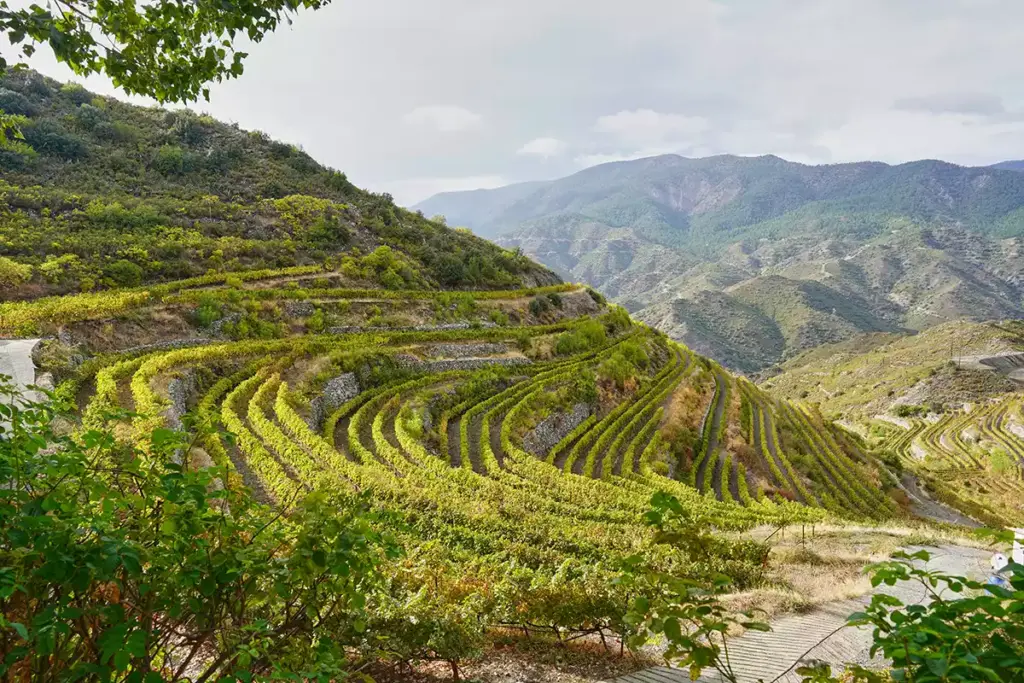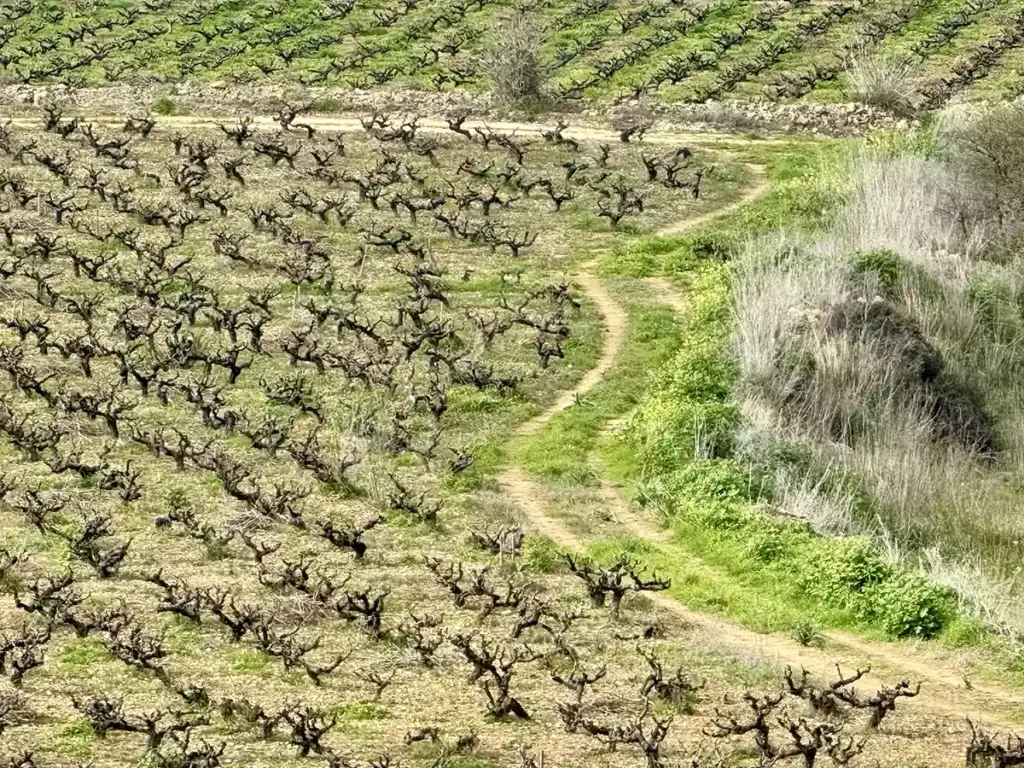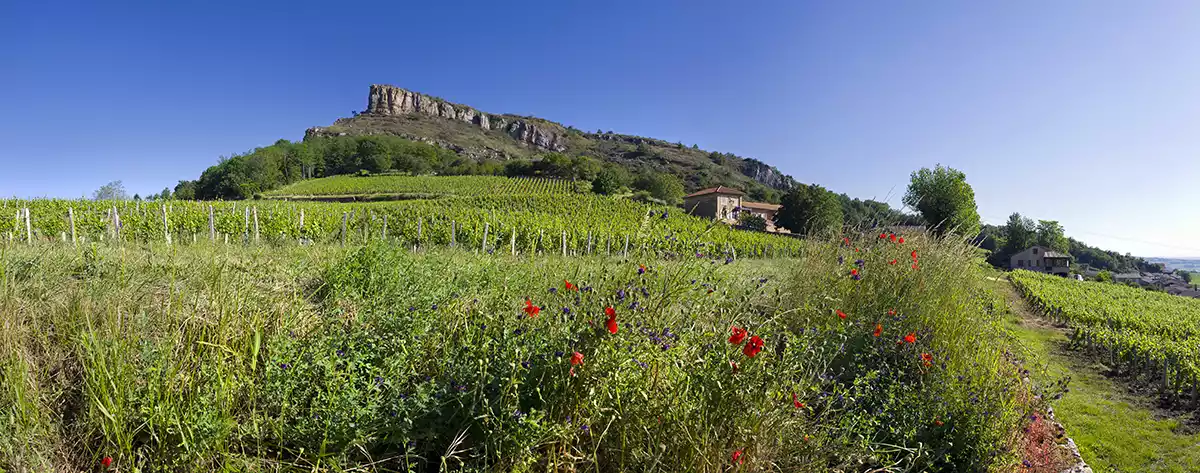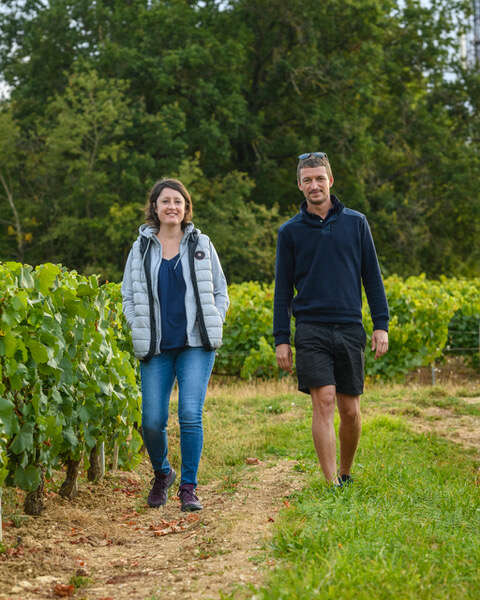
Cyprus has its share of modernist glass and concrete box wineries. The most dramatic is the newly opened Marathatra, literally knife-edged architecture perched precariously on a knife-edged ridge. Counterpointing these creations are decidedly less grand designs that have organically sprouted out of “mom and pop” family operations. What unites all are the mountain locations that often share spectacular views of 400+-year-old abandoned terraces on steep slopes opposite and, sometimes, below.
Also uniting them is a recent movement intent on recapturing Cyprus’s distinctive wine heritage, central to which are its long-lost native grape varieties.
Around 50 years ago, Cyprus consciously walked away from its local grapes and 6,000-year-old winemaking traditions, toward “international-style” New World varietal wines, based around French grape varieties, cool fermentation, and French oak barrels. A whole winemaking generation effectively lost contact with its vinous roots and Cyprus’s unique identity.
Orestis Tsiakkas sums it up, “We didn’t know where to plant or how to make wine out of these totally new ‘old’ native grapes. Yainnoudi, Maratheftiko, Xynisteri were always there, but were not taken seriously. But the results of experimentation were so good. And so now we are learning, relearning, rediscovering …”
Leading the charge is a 14-strong growers association called WineCore (Wineries of Cyprus Own-Rooted Evolution), focused on defining, promoting, and elevating Cyprus’s unique local varieties.
Here’s what they’re coming up with.
Xynesteri and Promara: Ancient Cyprus whites
Cyprus’s two main white grapes, Xynisteri and Promara, are thick-skinned, highly textured, and low on acid. All tricky challenges given today’s expectations of crisp, fruit-forward styles. Fortunately, both grapes, indeed all Cypriot grapes, have benefited from night picking, overnight refrigeration, and stainless steel’s cool fermentation.
Beyond technology, new plantations at elevations up to 1,535m (5,035ft) and selective exposure play a major role in Cypriot wine styles. Ever-windy, higher elevations, with 20+ degree diurnal temperature drops, and a return to the use of bush vines have lengthened growing periods, preserving delicate aromatics, finer textures, and natural acidity compared to fuller, fruiter, softer styles at elevations below 700m (2,300ft).
Xynisteri (pronounced Zin-i-steri, meaning low acidity) in particular is proving remarkably versatile, producing wine from bone dry to super sweet. Vasiliken’s winemaker Aphrodite Constanti sees Xynisteri dividing into three aromatic families with stone fruits, light blossoms, and tropicals (passionfruit and pineapple).
Higher up Xynisteri displays more aromatics, with crisper acidity and floral, lemony, beeswax, lanolin characters, while lower altitudes lean more toward nectarine, stone fruit, and green melon notes. Similarly, multi-layered textures range between very fine viscosity to unctuous oiliness.
At lower elevations, 700m-high vineyards on Cyprus’s far western side use sea breezes to deliver cool climate 11-12.5% ABV, varietal characters. With a clear view of the Mediterranean, Vasiliken’s sea of 65–100-year-old bush vines contribute to slower maturation.
Vineyard exposure can also create remarkable differences. Kyperounda for example, planted two Xynisteri vineyards at 1,200m (3,940ft). Both 2022s were 12.5%, but quite different wines. Their sun-drenched west-facing version offered up primary peach and mineral notes, light florals, a slick, full-bodied texture, and long melt-away finish, 18.5/20. Whereas their cooler, eastern, morning-sun-facing vineyard gave more floral, green herbal, and citrus-driven flavours, with considerably more acidity and much finer viscosity. 17.5/20
Xynisteri is also age-worthy. Kyperounda Petritis 2013 and 2004, for example, presented intriguing preserved lemon, zest, beeswax, and toast, tertiary development reminiscent of old Clare Valley Riesling or Savennières.
Harvested in August, Promara (meaning “earliest”) is the first Cypriot grape to mature. Like Xynisteri it is thick-skinned, so quite textural and with low yields. Darker-coloured, with slightly higher acidity, Promara’s fruits range from pears through green melons and cantaloupe.
Good examples are Tsiakkas’s high-altitude, finer, fresher, more floral version at 12.7% alcohol, Vlassides’s lower down, fuller version at 14%, and Zambara’s, which is stylistically somewhere in between.

Yiannoudi: A wild-grape hanger-on
Yiannoudi is an old red variety found in 500-year-old abandoned vineyards alongside Mavro and Xynisteri. An undomesticated wild-grape hanger-on, its female flowers require Xynisteri co-planted to pollinate, but Mavro and Syrah will also do the trick. Interplanting usually alternates every two or three vines, with experience teaching that higher ratios of Xynisteri can cause overproduction in Yiannoudi.
Yiannoudi’s aromatics and flavors tend toward herbal bay leaf and balsamic notes with a mix of savoury, roasted red and black fruits. Higher elevations produce more florals and black fruit characters; lower, warmerclimes deliver fuller-bodied, red-fruited wine, marked by high acidity and ultra-firm, sometimes chunky, tannins.
The ongoing trend over the last five years is for gentler handling, less extraction, and older oak, shifting Yiannoudi towards finer, more transparently elegant styles.
Good examples include Dufermou’s Yiannoudi, with marked bay leaf characters, juicy red fruits and firm, finely grained tannins. Tsiakkas’ higher altitude styles are more floral and black-fruited with softer tannins and vibrant acidity. The most elegant and refined versions I tasted were from Vlassides and Marathasa.
Maratheftiko: The rise of the trickster
Maratheftiko—a wonderfully unpronounceable name, meaning “trickster”—is another non-hermaphrodite grape needing pairing up with Spourtiko. Clearly a rising star, several winemakers praised its “wild” fruit characters: brambly mulberries, blackberries, blueberries, tinged with freshly picked strawberries and cherries.
Nelion winemaker Marios Loannou believes Maratheftiko was misunderstood early-on after having been mislabeled the “Cabernet of Cyprus” and “so people made it like that,” opting for an extractive, broodingly tannic style. Most certainly, under-tamed youthful versions can have full-on, lip-smacking Cab’ tannins. But more recently producers have seen it as more Pinot Noir-like, employing gentler handling for finer, more transparent expressions.
Zambartas Maratheftiko 2022 is very much in that big, bold, exuberantly black-fruited, chunkier style, but their powerfully expansive 2018 shows how time marries tannins and acidity into a better balance. 18.5/20
Nelion Maratheftiko 2020 plays to wilder, high-toned, florally violet notes, a fleshier velvety texture and thoroughly tamed tannins. 18/20
Lefkada is another red needing co-planting with Xynisteri, and is notoriously difficult in the vineyard and late ripening. Vasiliken’s Aphrodite Constanti grumbled, “its stems can be green even when ripe!” Exceedingly tannic, Lefkada demands light extraction and gentle handling to avoid astringency.
Vasiliken’s Lefkada 2018 (12.5% ABV) showed transparent spicy cinnamon and red fruit aromas, a velvety entry and sharp-edged tannins on the finish. 16/20
Bambakada seems perfect for Nerello Mascalese or Alfrocheiro lovers. The most impressive sampled was Tsiakkas’s Vamvakada (alternate spelling) 2021. At 13.7% ABV, it is a spirited mix of red and black fruit characters, silkily textured, finely structured, and deceptively persistent. 17/20
As for Mavro—the famous old mainstay of Commandaria—the few I tasted were delightfully straightforward, cherry-esque quaffers, light-bodied, finely tannined, and refreshingly juicy. Perfect dinner wines. The best of the lot, Tsiakkas Moulos 2022 (12.6% ABV) from 80-year-old vines. 16.5/20

The pithari question
The most tantalizing thing I found in Cyprus was the existence of dozens (hundreds…thousands?) of disused pithari clay pots decorating gardens, town squares, and wineries. Most were beautifully preserved examples of pots commonly used to make wine in Rome and throughout the Mediterranean 1,500-3,000 years ago.
It reminded me of the similarly displayed talha pots I saw back in Alentejo 15 years ago. Today most of those old talha are making highly prized wine again in both modern wineries and village restaurants.
It’s clear that pithari have been ideally suited to sun-dried grape fermentation and maturation for millenia, alongside the thick-skinned local whites and firmly-tannined red grapes that produced wines Cypriots drank on a day-to-day basis. What intrigues me about many native Cypriot grapes is whether they were specifically farmed and weeded out over time to suit Cyprus’s unique form of pithari. An intriguing question Cypriots will no doubt soon be solving for themselves.






